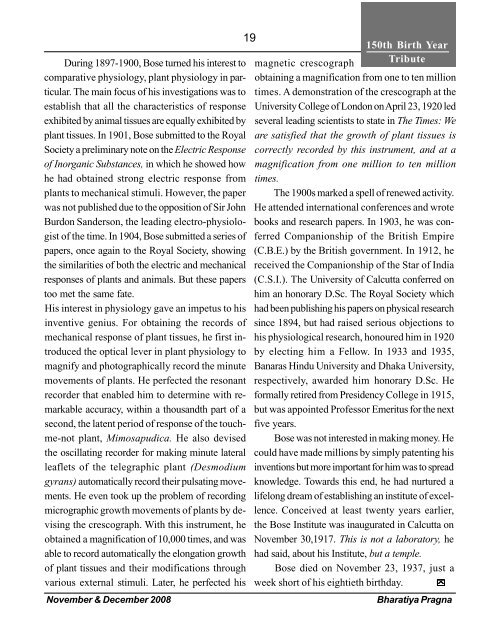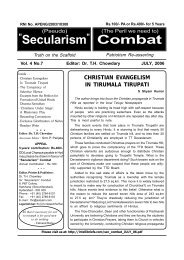Bharatiya Pragna - Dr. Th Chowdary
Bharatiya Pragna - Dr. Th Chowdary
Bharatiya Pragna - Dr. Th Chowdary
Create successful ePaper yourself
Turn your PDF publications into a flip-book with our unique Google optimized e-Paper software.
During 1897-1900, Bose turned his interest to<br />
comparative physiology, plant physiology in particular.<br />
<strong>Th</strong>e main focus of his investigations was to<br />
establish that all the characteristics of response<br />
exhibited by animal tissues are equally exhibited by<br />
plant tissues. In 1901, Bose submitted to the Royal<br />
Society a preliminary note on the Electric Response<br />
of Inorganic Substances, in which he showed how<br />
he had obtained strong electric response from<br />
plants to mechanical stimuli. However, the paper<br />
was not published due to the opposition of Sir John<br />
Burdon Sanderson, the leading electro-physiologist<br />
of the time. In 1904, Bose submitted a series of<br />
papers, once again to the Royal Society, showing<br />
the similarities of both the electric and mechanical<br />
responses of plants and animals. But these papers<br />
too met the same fate.<br />
His interest in physiology gave an impetus to his<br />
inventive genius. For obtaining the records of<br />
mechanical response of plant tissues, he first introduced<br />
the optical lever in plant physiology to<br />
magnify and photographically record the minute<br />
movements of plants. He perfected the resonant<br />
recorder that enabled him to determine with remarkable<br />
accuracy, within a thousandth part of a<br />
second, the latent period of response of the touchme-not<br />
plant, Mimosapudica. He also devised<br />
the oscillating recorder for making minute lateral<br />
leaflets of the telegraphic plant (Desmodium<br />
gyrans) automatically record their pulsating movements.<br />
He even took up the problem of recording<br />
micrographic growth movements of plants by devising<br />
the crescograph. With this instrument, he<br />
obtained a magnification of 10,000 times, and was<br />
able to record automatically the elongation growth<br />
of plant tissues and their modifications through<br />
various external stimuli. Later, he perfected his<br />
19<br />
150th Birth Year<br />
magnetic crescograph Tribute<br />
obtaining a magnification from one to ten million<br />
times. A demonstration of the crescograph at the<br />
University College of London on April 23, 1920 led<br />
several leading scientists to state in <strong>Th</strong>e Times: We<br />
are satisfied that the growth of plant tissues is<br />
correctly recorded by this instrument, and at a<br />
magnification from one million to ten million<br />
times.<br />
<strong>Th</strong>e 1900s marked a spell of renewed activity.<br />
He attended international conferences and wrote<br />
books and research papers. In 1903, he was conferred<br />
Companionship of the British Empire<br />
(C.B.E.) by the British government. In 1912, he<br />
received the Companionship of the Star of India<br />
(C.S.I.). <strong>Th</strong>e University of Calcutta conferred on<br />
him an honorary D.Sc. <strong>Th</strong>e Royal Society which<br />
had been publishing his papers on physical research<br />
since 1894, but had raised serious objections to<br />
his physiological research, honoured him in 1920<br />
by electing him a Fellow. In 1933 and 1935,<br />
Banaras Hindu University and Dhaka University,<br />
respectively, awarded him honorary D.Sc. He<br />
formally retired from Presidency College in 1915,<br />
but was appointed Professor Emeritus for the next<br />
five years.<br />
Bose was not interested in making money. He<br />
could have made millions by simply patenting his<br />
inventions but more important for him was to spread<br />
knowledge. Towards this end, he had nurtured a<br />
lifelong dream of establishing an institute of excellence.<br />
Conceived at least twenty years earlier,<br />
the Bose Institute was inaugurated in Calcutta on<br />
November 30,1917. <strong>Th</strong>is is not a laboratory, he<br />
had said, about his Institute, but a temple.<br />
Bose died on November 23, 1937, just a<br />
week short of his eightieth birthday. <br />
<br />
<br />
November & December 2008 <strong>Bharatiya</strong> <strong>Pragna</strong>



